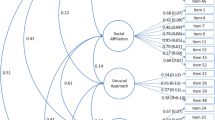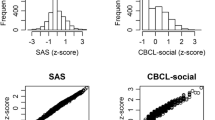Abstract
Three subtypes of autism based on social style have been proposed by Wing: active-but-odd, passive, or aloof. Previous research has shown evidence of an association between IQ and Wing subtype in untreated children and adults. Because IQ changes can accompany behavioral treatment, but often only for a subset of children, social subtype may be related to treatment responsiveness. We administered a social subtyping measure, the Wing Subgroups Questionnaire (WSQ), at various points in treatment to younger children than previously studied with autism in early, intensive behavioral intervention (EIBI). Thirty-seven children in EIBI (aged 39–71 months, amount of EIBI 0–44 months) were assessed to determine whether Wing’s three proposed subtypes were found in this sample and whether subtypes were associated with current IQ and change in IQ after a period of EIBI. Results confirmed that all three subtypes were present and correlated with IQ after a period of intervention, as well as with change in IQ. Participants classified as aloof had significantly lower IQ scores and changes in IQ after EIBI than other children. Future studies should extend these findings by examining whether social subtype at pretreatment predicts EIBI outcome.
Similar content being viewed by others
References
N. Bayley (1993) The Bayley scales of infant development-revised The Psychological Corporation San Antonio, TX
L. Beglinger T. Smith (2001) ArticleTitleA review of subtyping in autism and proposed dimensional classification model Journal of Austism and Developmental Disorders 31 411–422
M. C. Borden T. H. Ollendick (1994) ArticleTitleAn examination of the validity of social subtypes in autism Journal of Autism and Developmental Disorders 24 23–38
P. Castelloe G. Dawson (1993) ArticleTitleSubclassification of children with autism and pervasive developmental disorder: a questionnaire based on wing’s subgrouping scheme Journal of Autism and Developmental Disorders 23 229–241
G. Dawson L. Klinger H. Panagiotides A. Lewy P. Castelloe (1995) ArticleTitleSubgroups of autistic children based on social behavior display distinct patterns of brain activity Journal of Abnormal Child Psychology 23 569–583
D. Fein M. Stevens M. Dunn L. Waterhouse D. Allen I. Rapin C. Feinstein (1999) ArticleTitleSubtypes of pervasive developmental disorder: Clinical characteristics Child Neuropsychol. 5 1–23
L. Fitton (2000) ArticleTitleThe validity of the Wing Subgroup Questionnaire for assessing autism subtypes in young nonverbal children. Dissertation Abstracts International: Section B: The Sciences & Engineering 60 IssueID7-B 3562
G. Green (1996) Early behavioral intervention for autism: What does research tell us? C. Maurice G. Green (Eds) Behavioral Intervention for Young Children with Autism: A Manual for Parents and Professionals Austin TX 29–44
S. Harris J. Handelman (2000) ArticleTitleAge and IQ at intake as predictors of placement for young children with autism: A four- to six-year follow-up Journal of Autism and Developmental Disorders 30 137–142
T. L. Kemper M. L. Bauman (1993) ArticleTitleThe contribution of neuropathologic studies to the understanding of autism Neurologic Clinics 11 175–187
Larzelere Mulaik’s (2002) Modified Bonferroni approach D.C. Howell (Eds) Statistical Methods for Psychology EditionNumber5 Wadsworth Pacific Grove, CA
M. Lauritsen H. Ewald (2001) ArticleTitleThe genetics of autism Acta Psychiatrica Scandinavica 103 411–27
C. Lord E. Schopler (1989) ArticleTitleThe role of age at assessment, developmental level, and test in the stability of intelligence scores in young autistic children Journal of Autism and Developmental Disorders 19 483–499
I. Lovaas (1987) ArticleTitleBehavioral treatment and normal educational and intellectual functioning in young autistic children Journal of Consulting and Clinical Psychology 55 3–9
O. I. Lovaas T. Smith (1988) Intensive behavioral treatment for young autistic children B. B. A. E. Lahey Kazdin (Eds) Advances in clinical child psychology NumberInSeriesVol. 11 Plenum New York 285–324
C. Modahl L. Green D. Fein M. Morris L. Waterhouse C. Feinstein H. Levin (1998) ArticleTitlePlasma oxytocin levels in autistic children Biological Psychiatry 43 270–277
S. K. O’Brien (1996) ArticleTitleThe validity and reliability of the wing subgroups questionnaire Journal of Autism and Developmental Disorders 26 321–335
L. Schriebman (2000) ArticleTitleIntensive behavioral/psychoeducational treatments for autism: Research needs and future directions. (Special Issue: Treatments for people with autism and other pervasive developmental disorders: Research perspectives) Journal of Autism & Developmental Disorders 30 373–378
Smith, T. (1997, June 23). Girls with pervasive developmental disorders. Medscape Mental Health [On-line serial],2. Web address: www.medscape.com.
T. Smith P. A. Donahoe B. J. Davis (2000) The UCLA treatment model J. S. S. L. Handleman Harris (Eds) Preschool education programs for children with autism EditionNumber2 Pro-Ed Austin, TX: 23–39
T. Smith S. Eikeseth M. Klevstrand O. Lovaas (1997) ArticleTitleIntensive behavioral treatment for preschoolers with severe mental retardation and pervasive developmental disorder American Journal on Mental Retardation 102 238–249
T. Smith A Groen J. Wynn (2000) ArticleTitleA randomized trial of intensive early intervention for children with mild to moderate mental retardation and pervasive developmental disorder American Journal on Mental Retardation 106 269–285
J. Stevens (1986) Applied multivariate statistics for the social sciences Lawrence Erlbaum Associates Hillsdale, New Jersey 58
United States Surgeon General (1999). Mental health: A report of the Surgeon General. [Available on-line http://www.surgeongeneral.gov/library/mentalhealth/home.html].
F. Volkmar D. Cohen J. Bregman M. Hooks J. Stevenson (1989) ArticleTitleAn examination of social typologies in autism Journal of the American Academy of Child and Adolescent Psychiatry 28 82–86
L. Wing (1981) ArticleTitleLanguage, social, and cognitive impairments in autism and severe mental retardation Journal of Autism and Developmental Disorders 11 31–44
L. Wing (1997) Syndromes of autism and atypical development (Chapter 7) L. Cohen Volkmar (Eds) Handbook of Autism and Pervasive Developmental Disorders (2nd ed.) Wiley & Sons New York 148–172
L. Wing J. Gould (1979) ArticleTitleSevere impairments of social interaction and associated abnormalities in children: epidemiology and classification Journal of Autism and Developmental Disorders 9 11–29
Author information
Authors and Affiliations
Corresponding author
Rights and permissions
About this article
Cite this article
Beglinger, L., Smith, T. Concurrent Validity of Social Subtype and IQ after Early Intensive Behavioral Intervention in Children with Autism: A Preliminary Investigation. J Autism Dev Disord 35, 295–303 (2005). https://doi.org/10.1007/s10803-005-3292-3
Issue Date:
DOI: https://doi.org/10.1007/s10803-005-3292-3




